This was… interesting.
Jimmy Miller was the class leader, and he is a pretty big name these days on the SCA steak circuit; he is the points leader in Pennsylvania right now. This was his first time teaching, but I wouldn’t have guessed it. He has a process, and he simply talked to the class as he followed it. He is friendly and engaging, and thorough.

He started by showing the different ribeyes: big end/tri-muscle, spinalis, and “the one nobody wants” (all eye and small spinalis). He then showed how to trim them for competition. We all got to try our hand at trimming steaks.





At this point, though, it really goes sideways for us backyard guys and gals, as he starts going over what he uses as rubs and marinades, about using tweezers to pick fat out of the spinalis, about Jaccarding the fat that can’t be removed, etc.. These folks use A LOT of seasonings. This is just the stuff that goes into the marinade.

There were just as many that become two different layers of rubs. I didn’t bother to listen to the names, except he too is looking for that one that went out of business. (Edit: Oak Ridge Black Ops.)
We broke for lunch: pulled pork on Martin’s potato buns with Blues Hog. The pork was a good solid offering, exactly what you would want yours to taste like.
After lunch there was more about the competition process, taking the steak from the marinade, tying the steak to puff it up and pinning it to hold it together, and then all the different powders and potions. My mind wandered here; I thought about how cool it is that people get so obsessed about some things. About how one rub is used solely because it brings a nice burnished color to the steak, about how it’s important to go around the steak with bonsai clippers trimming little pieces of fat so the judges don’t bite into them, etc.. I took photos, but they didn’t upload to the cloud yet. They look like the other ones, but the steak is darker.
There was talk about time and temperature. The important parts were “I don’t do this at home” and “All this depends on a lot of other factors”. But there was nevertheless an important message, maybe the most important for the home cook: consistency and repeatability. There is no substitute for cooking a lot of steaks on a cooker that you know well! This lesson didn’t photograph well. He pulls his steaks to match a competition standard for color and tenderness, but the principle is applicable regardless of your goal for your steak.
It’s time to cook… Jimmy uses a PK! He loves the simplicity, portability, and durability.
Right before the steak goes on, he scrapes all the rub off the presentation side:

I’m going to hit the photo limit if I keep this up, so I’ll skip some of this and get right to the results:


There was a lot about how to get those grill marks (grill grates bolted to the PK grates), brushing with butter and anchovy paste, etc. You want obsessive? If the crosshatch doesn’t go far enough, he has a pen (with edible ink) that he uses to draw them to the edges.
“But Mosca! We’re dying to know! After all this, WHAT DOES THE STEAK TASTE LIKE?”
Friends, it tasted like shit.
It was salty. It was unfocused. It was all umami without any meatiness. It was tender, but also not chewy enough. The whole thing was as if it was more focused on a good LOOKING steak rather than a good TASTING steak. I was surprised, but also not surprised in that I watched everything that was done. I feel pretty bad saying this. Everyone was so nice, so friendly, so gracious… it is what it is, though. If I cooked that steak, I would throw it out before I would serve it.
There was only the one grill. We all had the opportunity to stick around and do our own cook, but I’d seen enough. I didn’t want to learn that, I just wanted to take the process and apply it to my tastes.
In the end, it confirmed that I’m not interested in competitive cooking. These people cook to a standard that can be judged, and a lot of that is appearance which can be objectively measured; taste is subjective, and anyhow all perfect steaks should taste the same… like perfect beef, perfectly cooked. And if that were the case in the competition, nobody would win, there would be a 300-way first place tie.
But it was nevertheless a blast. Lancaster BBQ Supply is a cool store with good products and knowledgable people. The competition team folks were all great. Jimmy was wonderful, the food (pork) was excellent, and while the steak isn’t what I would make, the process is one I can use at home for making MY steaks the way I want to.
Jimmy Miller was the class leader, and he is a pretty big name these days on the SCA steak circuit; he is the points leader in Pennsylvania right now. This was his first time teaching, but I wouldn’t have guessed it. He has a process, and he simply talked to the class as he followed it. He is friendly and engaging, and thorough.
He started by showing the different ribeyes: big end/tri-muscle, spinalis, and “the one nobody wants” (all eye and small spinalis). He then showed how to trim them for competition. We all got to try our hand at trimming steaks.
At this point, though, it really goes sideways for us backyard guys and gals, as he starts going over what he uses as rubs and marinades, about using tweezers to pick fat out of the spinalis, about Jaccarding the fat that can’t be removed, etc.. These folks use A LOT of seasonings. This is just the stuff that goes into the marinade.
There were just as many that become two different layers of rubs. I didn’t bother to listen to the names, except he too is looking for that one that went out of business. (Edit: Oak Ridge Black Ops.)
We broke for lunch: pulled pork on Martin’s potato buns with Blues Hog. The pork was a good solid offering, exactly what you would want yours to taste like.
After lunch there was more about the competition process, taking the steak from the marinade, tying the steak to puff it up and pinning it to hold it together, and then all the different powders and potions. My mind wandered here; I thought about how cool it is that people get so obsessed about some things. About how one rub is used solely because it brings a nice burnished color to the steak, about how it’s important to go around the steak with bonsai clippers trimming little pieces of fat so the judges don’t bite into them, etc.. I took photos, but they didn’t upload to the cloud yet. They look like the other ones, but the steak is darker.
There was talk about time and temperature. The important parts were “I don’t do this at home” and “All this depends on a lot of other factors”. But there was nevertheless an important message, maybe the most important for the home cook: consistency and repeatability. There is no substitute for cooking a lot of steaks on a cooker that you know well! This lesson didn’t photograph well. He pulls his steaks to match a competition standard for color and tenderness, but the principle is applicable regardless of your goal for your steak.
It’s time to cook… Jimmy uses a PK! He loves the simplicity, portability, and durability.
Right before the steak goes on, he scrapes all the rub off the presentation side:
I’m going to hit the photo limit if I keep this up, so I’ll skip some of this and get right to the results:
There was a lot about how to get those grill marks (grill grates bolted to the PK grates), brushing with butter and anchovy paste, etc. You want obsessive? If the crosshatch doesn’t go far enough, he has a pen (with edible ink) that he uses to draw them to the edges.
“But Mosca! We’re dying to know! After all this, WHAT DOES THE STEAK TASTE LIKE?”
Friends, it tasted like shit.
It was salty. It was unfocused. It was all umami without any meatiness. It was tender, but also not chewy enough. The whole thing was as if it was more focused on a good LOOKING steak rather than a good TASTING steak. I was surprised, but also not surprised in that I watched everything that was done. I feel pretty bad saying this. Everyone was so nice, so friendly, so gracious… it is what it is, though. If I cooked that steak, I would throw it out before I would serve it.
There was only the one grill. We all had the opportunity to stick around and do our own cook, but I’d seen enough. I didn’t want to learn that, I just wanted to take the process and apply it to my tastes.
In the end, it confirmed that I’m not interested in competitive cooking. These people cook to a standard that can be judged, and a lot of that is appearance which can be objectively measured; taste is subjective, and anyhow all perfect steaks should taste the same… like perfect beef, perfectly cooked. And if that were the case in the competition, nobody would win, there would be a 300-way first place tie.
But it was nevertheless a blast. Lancaster BBQ Supply is a cool store with good products and knowledgable people. The competition team folks were all great. Jimmy was wonderful, the food (pork) was excellent, and while the steak isn’t what I would make, the process is one I can use at home for making MY steaks the way I want to.







 And you saved me some money.
And you saved me some money.


Comment